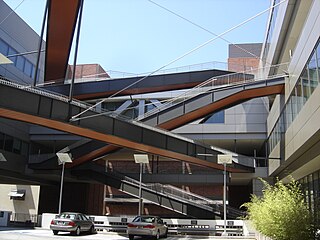
Utah State University is a public land-grant research university with its main campus in Logan, Utah. It is accredited by the Northwest Commission on Colleges and Universities. With nearly 20,000 students living on or near campus, USU is Utah's largest public residential campus. As of Fall 2022, there were 27,943 students enrolled, including 24,835 undergraduate students and 3,108 graduate students.
A business incubator is an organization that helps startup companies and individual entrepreneurs to develop their businesses by providing a fullscale range of services starting with management training and office space and ending with venture capital financing. The National Business Incubation Association (NBIA) defines business incubators as a catalyst tool for either regional or national economic development. NBIA categorizes its members' incubators by the following five incubator types: academic institutions; non-profit development corporations; for-profit property development ventures; venture capital firms, and a combination of the above.

Carnegie Mellon Silicon Valley is a degree-granting branch campus of Carnegie Mellon University located in the heart of Silicon Valley in Mountain View, California. It was established in 2002 at the NASA Ames Research Center in Moffett Field.
The Small Business Innovation Research program is a U.S. government funding program, coordinated by the Small Business Administration, intended to help certain small businesses conduct research and development (R&D). Funding takes the form of contracts or grants. The recipient projects must have the potential for commercialization and must meet specific U.S. government R&D needs.

Florida Polytechnic University is a public university in Lakeland, Florida. Created as an independent university in 2012, it is the newest of the 12 institutions in the State University System of Florida. It is the state's only public polytechnic university, and focuses solely on STEM education.

The California NanoSystems Institute (CNSI) is an integrated research center operating jointly at UCLA and UC Santa Barbara. Its missions are to foster interdisciplinary collaborations for discoveries in nanosystems and nanotechnology; train the next generation of scientists, educators and technology leaders; and facilitate partnerships with industry, fueling economic development and the social well-being of California, the United States and the world.

Gina Colarelli O'Connor is Professor of Innovation Management at Institut Universitaire de France, where she has worked since January 2019. She leads Babson's executive education programs in corporate innovation.
Innovista is the economic development arm of the University of South Carolina.
Technological Research and Development Authority (TRDA) was an Independent Special District of the state of Florida. As a technology-based economic development organization it focuses upon the incubation of new business ventures, the acceleration of growth of existing firms and the commercialization of innovative technologies.
Utah State University Uintah Basin is a part of the Utah State University (USU) Statewide Campuses system located in Roosevelt, Utah, with an additional campus in Vernal. The Uintah Basin campus was the first USU regional campus. USU Uintah Basin offers more than 60 degrees, ranging from associates through doctorates, as well as certificate programs.
Ablitech, Inc. is a biotechnology company founded in Hattiesburg, Mississippi, USA, that specializes in the development and commercialization of platform technologies that heal and protect the human body.

The U.S. state of Utah has the solar potential to provide all of the electricity used in the United States. Utah is one of the seven states with the best potential for solar power, along with California, Nevada, Arizona, New Mexico, Colorado, and Texas. Utah's only investor owned utility currently allows partial net metering for residential systems up to 25 kW and up to 2 MW for non-residential users. In the past RMP allowed full net metering, and partial net metering. Neither of these Schedules allows for new customers to sign up any longer. Utah's municipal utilities and electric cooperatives set their own net metering policies.

Research Park at the University of Illinois Urbana-Champaign is a research park located in the southwest part of the University of Illinois Urbana-Champaign campus in Champaign, Illinois. Research Park is a technology hub for startup companies and corporate research and development operations. Within Research Park there are more than 120 companies employing more than 2,100 people including students and full-time technology professionals.
3C Institute is a private, for-profit research and development company based in Durham, North Carolina which develops "web- and game-based applications and technology solutions designed to improve the health and well-being of youth and families." The company partners with researchers, program providers, non-profits, and companies to develop customized digital information delivery systems, such as personalized games, e-training courses, and web-based assessments. 3C Institute also develops evidence-based social emotional learning products for children, adolescents, and parents.

Made In Space, Inc. (MIS) is an American company specializing in the engineering and manufacturing of three-dimensional printers for use in microgravity. Headquartered in Jacksonville, Florida, Made In Space's 3D printer was the first manufacturing device used in space.
KLE Technological University, formerly known as B. V. Bhoomaraddi College of Engineering and Technology (BVBCET), colloquially the BVBCollege, is a private university in Hubli-Dharwad, Karnataka, India. It was upgraded to a university under the KLE Technological University Act, 2012. The school was founded by the KLE Society, Belgaum, in 1947.

Bruce Bugbee is an American scientist. His work includes research into space farming with NASA and at Utah State University, where he is the Director of the Crop Physiology Laboratory.
Neighbor is an American company that provides an online marketplace for peer-to-peer and traditional self storage.

CIIE.CO is an Indian startup accelerator and incubator that supports early-stage startups located at IIM Ahmedabad in Ahmedabad, India. It was founded in 2002 to promote innovation and entrepreneurship in India. It is a Center of excellence set up at Indian Institute of Management Ahmedabad with support from the Government of India's Department of Science and Technology and the Government of Gujarat.
Andrea P. Belz is an American innovation engineer, academic and author. She is a Professor of Practice in Industrial and Systems Engineering and the Vice Dean of Transformative Initiatives in the Viterbi School of Engineering at the University of Southern California (USC).













